Scottish independence: The styles of Cameron and Salmond
- Published
The North Sea has become the latest battleground in the Scottish independence campaign, with strains of the classic SNP slogan "It's Scotland's oil" again taking centre stage.
Ahead of the 18 September referendum, Prime Minister David Cameron said oil and gas reserves could be better managed with Scotland as part of the Union, while Scottish First Minister Alex Salmond has articulated his dream to transform the lives of Scots with a Norwegian-style oil fund, delivered by a "Yes" vote.
But it was the backdrop of events this week - the two rival cabinets meeting separately within a few miles of each other in and around Aberdeen - which really got observers excited.
So how do the differing styles of Mr Cameron and Mr Salmond compare, and how did the press respond to these approaches?
The Cabinet meetings
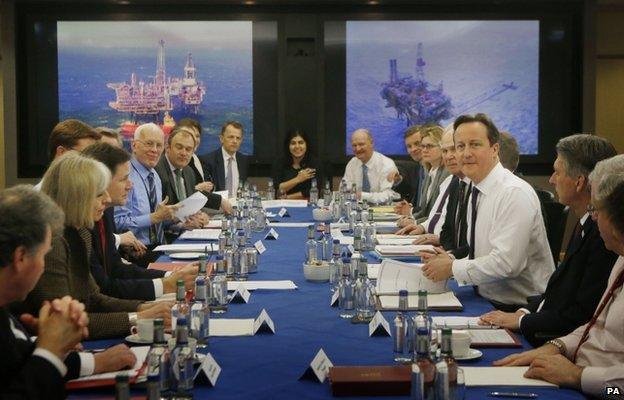
The UK government has not met all that often in Scotland. Aside from the one Gordon Brown led in Glasgow in 2009, it previously ventured north of the border for a session in 1921.
This time, Mr Cameron and his senior ministers gathered at Aberdeen's Shell UK offices, as he announced measures which aimed to make the most of remaining North Sea oil and gas reserves.
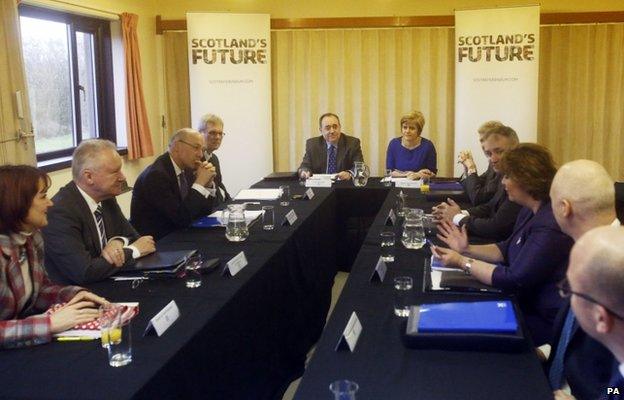
Mr Salmond has been taking his cabinet "on tour" around Scotland some some years. The location for this meeting was Portlethen Parish Church, in Aberdeenshire.
Chris Gilmour, a director at the PR firm Beattie Communications, said the the cabinet face-off gave the opposing sides the chance to "go into overdrive".
"The opposing cabinets went head-to-head in the battle for hearts, minds and votes," said Mr Gilmour. "The meetings took place just seven miles apart, but the messages delivered could have come from different planets.
"The first minister and his colleagues gathered in a modest church hall in Portlethen, while the prime minister chose the Aberdeen HQ of oil giant Shell.
"Each side is clearly playing to their perceived strengths. David Cameron and his coalition cabinet have always presented themselves as the sensible, pro-business choice, and we were told that the oil industry was borne on the UK's 'broad shoulders'.
"Mr Cameron was slick and focused on the job. He sat at the centre of the table in shirt sleeves, clearly delivering the message that his approach is collaborative.
"But suggesting that Scotland cannot afford to manage the oil industry is a dangerous game to play and one that opens the door for Alex Salmond to appeal to the masses."
According to Mr Gilmour, even the smallest details will have been considered in terms of how they might be interpreted - including the water chosen by each government.
"Mr Cameron may have clawed back some support however by having Scottish water bottles on the boardroom table, as the SNP opted for jugs," he said.
"Or does it back up Mr Salmond's argument that the UK government is profligate with Scotland's natural resources?"
The photo opportunities
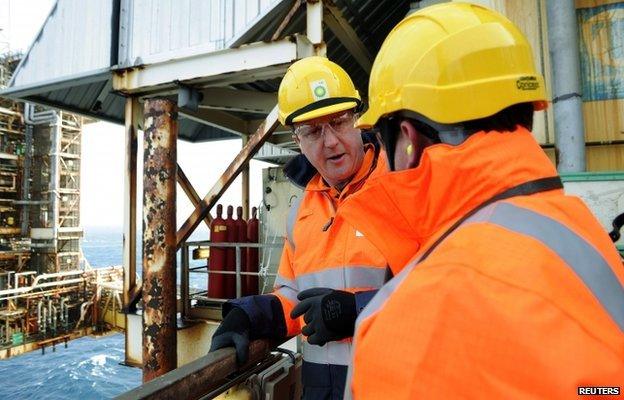
Mr Cameron arrived in the north east before heading out to the BP Eastern Trough Area Project oil platform in the North Sea.
He posed for pictures and spoke to journalists while visiting the instillation, about 100 miles east of Aberdeen.
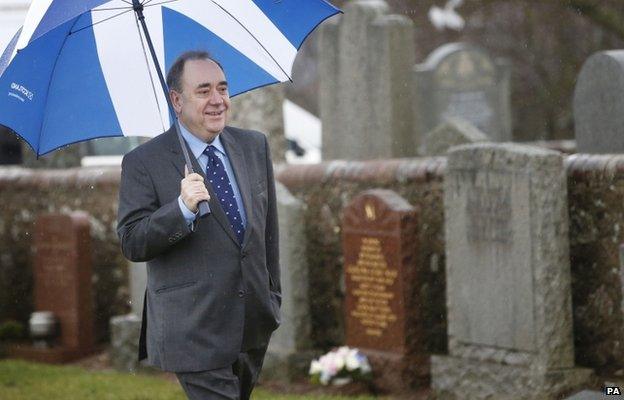
Back on terra firma, Mr Salmond arrived at the parish church - brolly in hand - for his cabinet meeting, before later taking part in a public Q&A session on Scotland's future.
How did the newspapers cover the visits?
The very idea of two rival governments pitching up at the same time in Europe's oil capital to set out their rival visions for the industry was essentially a journalists' dream - and Scotland's tabloids did not hold back.
Daily Record
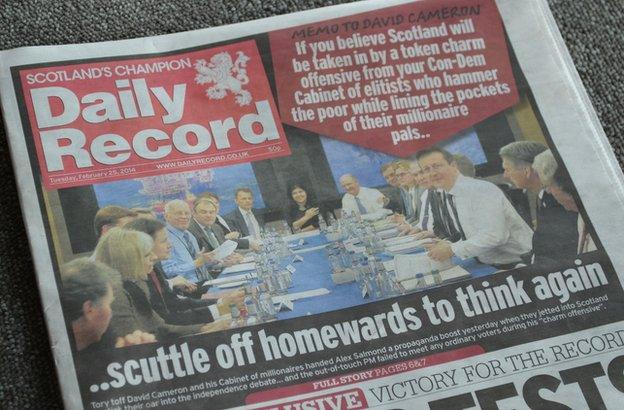
The Daily Record - traditionally a Labour-supporting paper - seemed to take the strongest line, with its declaration that the UK government visit had handed Mr Salmond a "propaganda boost".
Its front page featured a mocked-up memo to David Cameron, which read: "If you believe Scotland will be taken in by a token charm offensive from your Con-Dem Cabinet of elitists who hammer the poor while lining the pockets of their millionaire pals . . . scuttle off homewards to think again."
The Scottish Sun

The Scottish Sun noted that, while the two cabinets met only a few miles away from each other, their competing visions for the future of North Sea oil and gas meant they were "worlds apart".
Sun Scottish political editor Andrew Nicoll bestowed on the prime minister the nickname of "David Camouflage", arguing his locations of choice - including an oil instillation in the North Sea - meant little chance of the public getting to meet him.
Scottish Daily Mail
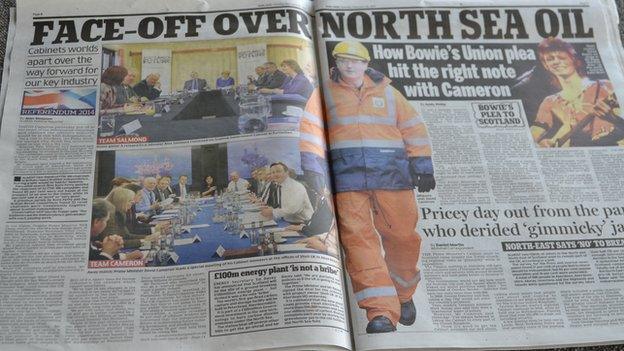
A double-page spread in the Scottish Daily Mail described what went down as a "face-off over North Sea Oil", reporting that Mr Cameron's decision to put the issue at the heart of the referendum campaign was met with Mr Salmond's demands for an apology for "squandering" the valuable resource.
The picture captions note a "relaxed" first minister holding his cabinet session in Portlethen, compared to the prime minister's leading of a "special meeting" of his senior ministers at Aberdeen's Shell UK offices.
David Hutchison, visiting professor in media policy at Glasgow Caledonian University, said the tabloid coverage of events was particularly interesting.
"The Daily Record has difficult contradictions to resolve," he added. "It backs the Union, and Labour, but has a broad audience including many 'Yes' voters.
"The danger for the Record is that it alienates readers, especially since economic conditions continue to be extremely difficult for newspapers.
"As a Union-supporting paper it could have chosen to laugh at Salmond for convening his cabinet in a church hall, but instead it focuses on the 'Tory elitists'.
"The tone of piece almost says 'if you want to get rid of them, vote yes', but of course the paper supports the Union.
"I don't know how the Record is going to resolve this tension going forward - it's very intriguing."
'Politicised tone'
Prof Raymond Boyle, of the University of Glasgow's centre for cultural policy research, said the "highly politicised" tone of the day was key to the coverage.
"The slightest nuances around geography or popular cultural references are going to be used," said Prof Boyle.
"Most papers reinforce what readers want to know and tailor their stories accordingly.
"We can see this with the Daily Record's coverage. The narrative of the prime minister jetting in with his Eton-educated cabinet is well established, and the Record coverage plays in to this and confirms how they think their readers will feel about this approach.
"Once these cultural narratives are established, it can be very difficult to shift the climate of opinion around them.
"It would be interesting to see how the English-based media covered the story - I suspect the coverage would be quite different."
Broadsheet coverage
The Herald wrote that the first minister had upped the referendum rhetoric, external by branding Westminster politicians "thieves" for allegedly squandering the nation's oil and gas reserves.
The Scotsman took a slightly different approach to the story, reporting Mr Salmond had given the clearest signal yet, external that his "Plan B" for currency in an independent Scotland would be to use the pound informally, if a sterling zone with the rest of the UK was rejected.